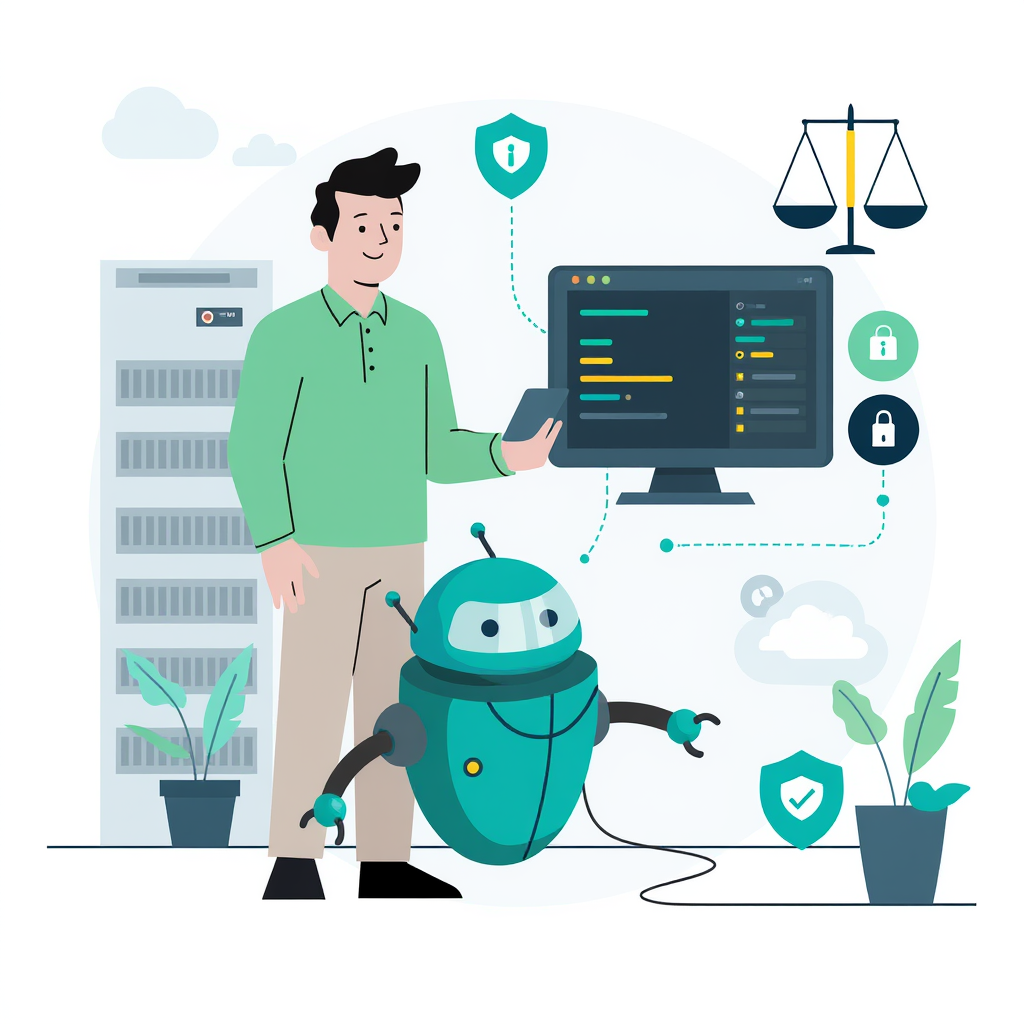Modern development teams face a complex challenge: maintaining rapid deployment cycles while meeting security compliance requirements. Traditional security approaches create bottlenecks that slow development velocity and frustrate engineering teams. DevSecOps offers a solution by integrating security practices directly into development workflows, enabling automated compliance without sacrificing speed.
This approach transforms security from a roadblock into an enabler, using policy-as-code, automated evidence collection, and continuous compliance monitoring to maintain both velocity and regulatory adherence. For organisations that need to comply with EU frameworks like DORA and NIS2, DevSecOps provides a pathway to achieve compliance while preserving the agility important for competitive advantage. Our comprehensive guide to DORA and NIS2 compliance explores these frameworks in detail.
Through practical strategies for implementing DevSecOps principles, selecting appropriate tools, and managing organisational transformation, you can balance security compliance with development velocity effectively. The key lies in embedding security validation throughout the software development lifecycle rather than treating it as a separate phase that occurs after development.
What is DevSecOps and how does it differ from traditional security approaches?
DevSecOps operates as a shared responsibility model, with ownership but no silos where security teams define strategy and controls while development teams implement controls in their workflow. This shift-left approach enables continuous security validation and compliance checking without creating deployment bottlenecks.
Traditional security approaches create bottlenecks that slow deployment velocity and frustrate development teams, while DevSecOps integrates security practices directly into development workflows. The fundamental difference lies in timing and responsibility distribution.
In traditional models, security reviews happen at the end of development cycles, creating approval gates that can halt deployments. DevSecOps embeds security measures throughout the software development lifecycle, enabling early detection and resolution of security issues. Automated early pipeline stages include static code analysis, dependency scanning, and secret detection while maintaining human oversight for complex deployment decisions.
The cultural transformation required for DevSecOps success centres on establishing collaborative environments where security and development teams work together seamlessly. This collaborative approach reduces false positives through continuous rule refinement in automated security tools, balancing speed, security, and developer productivity.
How does policy-as-code enable automated compliance without slowing development?
Policy-as-code translates compliance requirements into technical policies that can be automatically tested and enforced throughout the development pipeline. This approach eliminates manual policy interpretation and enables real-time compliance validation during development rather than retrospective auditing. For practical implementation guidance, see our detailed article on implementing policy-as-code for continuous compliance.
Infrastructure-as-Code (IaC) templates with hardening standards enable automated compliance enforcement, creating consistent security configurations across environments. Version-controlled policy definitions can be tested alongside application code, ensuring policies evolve with your applications and maintain alignment with business requirements.
The implementation strategy focuses on continuous compliance through real-time policy enforcement during CI/CD pipeline execution. Compliance dashboards provide automated visibility into compliance status, eliminating manual reporting overhead and providing stakeholders with up-to-date compliance information. These dashboards enable proactive risk management rather than reactive compliance checking, supporting audit documentation as a continuous process rather than a point-in-time activity.
Governance frameworks require establishment before policy deployment, with policies distinguishing between customer-facing code and internal tools. Automated quality gates can trigger enhanced reviews based on predefined criteria, demonstrating how policy-as-code adapts to modern development practices.
Organisations require structured application and governance frameworks that include comprehensive code review requirements and security compliance measures. Setting appropriate security scanning requirements and modifying code review processes accordingly ensures policy-as-code remains effective as development practices evolve.
Open Policy Agent (OPA) represents a leading technical implementation for policy-as-code, providing a unified framework for policy definition and enforcement across your technology stack. OPA enables you to write policies in a high-level declarative language called Rego, which can express complex security and compliance requirements. These policies can be version-controlled alongside your application code and automatically evaluated during CI/CD pipeline execution. The integration with existing CI/CD systems enables seamless policy validation without disrupting developer workflows, while providing real-time feedback on compliance violations.
What automated evidence collection strategies support continuous compliance monitoring?
Automated evidence collection uses technology to automatically gather, organise, and update documentation required for audits, reducing manual effort and ensuring continuous compliance readiness. This approach transforms compliance from a manual burden into a strategic, efficient process.
Real-time logging of every access request and activity, including policy updates, evidence uploads, and changes to assignees, is important for compliance transparency and accountability. This comprehensive audit trail provides the foundation for demonstrating compliance to regulators and auditors.
Evidence collection architecture requires integration with existing development tools to capture security controls, testing results, and deployment activities in real-time. Continuous compliance involves automated monitoring of controls, real-time assessments, and proactive risk management embedded into daily operations.
GRC platforms like RSA Archer and MetricStream provide comprehensive evidence collection automation, while SIEM systems like Splunk and IBM QRadar offer automated security evidence gathering capabilities. The selection depends on your existing technology stack and compliance requirements.
Automated compliance reporting solutions with extensive integration capabilities enable generation of detailed, accurate reports at predetermined frequencies. This eliminates last-minute data collection and reduces human errors during audit processes.
Cloud-based compliance management systems with automated evidence collection capabilities offer scalability and integration advantages. Robotic process automation (RPA) tools provide systematic evidence gathering and documentation, while analytics enhance evidence quality and ensure data integrity.
How do you implement CI/CD pipeline security without impacting deployment velocity?
Automate early pipeline stages while maintaining human oversight for complex deployment decisions. This approach ensures security validation occurs continuously without creating deployment bottlenecks. Key automated stages include:
- Static code analysis
- Dependency scanning
- Secret detection
Parallel processing becomes important when maintaining velocity while adding security controls. Implement parallel security testing alongside development workflows to avoid sequential bottlenecks that would slow deployment cycles. Self-healing systems provide proactive prevention and learning capabilities, analysing failures to achieve higher protection and handling future failures more effectively. These systems lead to improved reliability, making your infrastructure resilient through proactive management rather than reactive problem-solving. Automated issue resolution helps ensure resource reallocation that assigns additional memory, computing or storage to manage bottlenecks.
Container security becomes fundamental for modern deployment pipelines, requiring automated scanning and policy enforcement. Container registry security enables storing container images in a secure and highly available manner, with options for hosted or on-premises deployment. Every open source component needs scanning for threats and vulnerabilities, with version updates and patches managed systematically to maintain security without disrupting development velocity. Popular container security tools include Twistlock, Aqua Security, and Sysdig Falco, which provide runtime protection and vulnerability scanning integrated into your CI/CD pipelines.
Risk-based security testing optimises resource allocation by prioritising high-impact security checks based on threat models and business criticality. Continuous monitoring and anomaly detection enables timely detection and resolution of disruptions while minimising downtimes. This approach ensures security measures enhance rather than hinder system reliability by focusing testing efforts on the most critical vulnerabilities and attack vectors.
Security tool integration requires careful consideration of performance impact. SAST tools for static code analysis, DAST tools for dynamic application security testing, and SCA tools for software composition analysis must integrate seamlessly with existing CI/CD workflows. Encrypted channels such as TLS or SSH safeguard data in transit during CI/CD processes, while automated transfer tools with built-in error recovery mechanisms ensure secure data handling without manual intervention.
What are the key EU compliance requirements affecting DevSecOps implementation?
DORA became mandatory on January 17, 2025, requiring financial entities to implement five pillars:
- ICT risk management
- Incident management
- Digital operational resilience testing
- Third-party risk management
- Information sharing
This regulation focuses on effective mitigation of ICT-related cybersecurity risks for the financial sector through dedicated control functions. For a comprehensive breakdown of these requirements, our article on understanding DORA and NIS2 requirements for tech companies provides detailed implementation guidance.
NIS2 came into effect in October 2024, imposing cybersecurity requirements on organisations within EU Member States to strengthen their cybersecurity posture. The directive has broader focus, covering sectors like:
- Energy
- Healthcare
- Transport
- Banking
- Digital infrastructure
- Government
- Manufacturing
- Research institutions
Both DORA and NIS2 may apply to organisations domiciled outside the EU if they provide services to entities within Member States, extending compliance requirements to global technology companies serving European markets. Organisations must ensure full compliance by meeting both specific requirements of DORA and general requirements of NIS2 where both apply.
DORA applies to financial entities including banks, investment firms, insurance companies, and payment service providers. DORA aims to ensure stability of the EU’s finance and insurance sectors by strengthening their resilience to ICT threats, requiring comprehensive risk management frameworks.
Practical DORA compliance implementation requires:
Core requirements for NIS2 compliance include:
Standardised incident reporting and employee training on digital resilience become mandatory components of compliance programmes. DevSecOps provides the automation and continuous monitoring capabilities required to meet these regulatory obligations efficiently.
GDPR requirements integrate with both DORA and NIS2, creating comprehensive data protection and security obligations. EU Financial Services regulations add sector-specific compliance considerations that DevSecOps practices can address through automated policy enforcement and evidence collection.
How do you select and implement the right DevSecOps tools for your organisation?
DevSecOps tool selection requires evaluating security testing capabilities, integration compatibility, performance impact, and compliance support against specific organisational requirements. To demonstrate ROI and guide selection criteria, baseline current metrics including:
- Cycle time
- Code quality
- Security vulnerabilities
- Developer satisfaction
Implementation involves establishing governance frameworks before deployment, with policies distinguishing customer-facing code from internal tools. This governance approach ensures tools integrate effectively with your existing development processes while maintaining security standards.
Evaluation criteria matrices for SAST, DAST, and SCA tools should consider integration compatibility with existing CI/CD systems. The matrix should evaluate factors including:
- Detection accuracy
- False positive rates
- Scanning speed
- Language support
- Reporting capabilities
Tools like SonarQube for SAST, OWASP ZAP for DAST, and Snyk for SCA provide different strengths that should align with your specific technology stack and security requirements.
The implementation approach focuses on controlled expansion and training. A semiconductor company assigned “Copilot Champions” from their pilot team to each expansion cohort, achieving 85% satisfaction rates compared to 60% for top-down training alone. This champion model applies broadly to DevSecOps tool adoption, where local experts help teams navigate integration challenges and share practical usage patterns.
Effective usage requires training covering secure usage patterns specific to your tech stack using actual code from your repositories. Generic training programmes fail to address the specific integration challenges and security patterns relevant to your development environment.
A controlled expansion and continuous improvement strategy is key:
- Implement expansion at approximately 20% weekly, with mandatory training and pair programming during the first week.
- Create continuous improvement loops through monthly retrospectives and quarterly policy updates.
- Use weekly satisfaction surveys to provide early warning signs of implementation issues.
Performance benchmarking and total cost of ownership analysis guide selection decisions between security testing tools, cloud security platforms, and policy management platforms. Integration compatibility assessment ensures selected tools work effectively within your existing technology ecosystem.
What organisational strategies support successful DevSecOps adoption?
Leadership plays a pivotal role in shaping DevSecOps adoption within technical teams through active endorsement and normalisation of tools. Clear communication about approved solutions, their intended use cases, and adoption expectations is important for leadership success in driving organisational change.
Security Champions should be established within engineering teams to bridge security and development practices. These champions serve as trusted sources, sharing knowledge through informal sessions, live demonstrations, and brown bag meetings that make DevSecOps practices accessible to development teams. Organisations that cultivate local champions typically see marked increase in adoption rates, as practical examples foster relevance and confidence among peers.
The Security Champions programme structure should include formal nomination processes, regular training sessions, and clear responsibilities for knowledge transfer. Champions receive advanced training in security practices and serve as the first point of contact for security questions within their teams. They also participate in security design reviews and help establish secure coding standards. This decentralised approach ensures security expertise is embedded throughout the organisation while maintaining connection to centralised security teams.
Peer learning rather than top-down mandates proves effective for technology adoption, creating sustainable change through organic knowledge transfer. Change management strategies must address cultural resistance and provide practical support for teams transitioning from traditional security approaches. Change management remains one of the most overlooked components in adoption, with employees wary of automation often resisting adoption in subtle but impactful ways.
Training programmes require customisation for development teams on security practices specific to your technology stack. Business users need education on several key points:
- How these systems work
- What they can and can’t do
- How to integrate insights into decision-making
This educational approach positions tools as collaborative assistants rather than replacements.
Metrics and measurement strategies focus on group performance rather than individual assessment to encourage accountability without fostering mistrust. Use dashboards and scorecards to provide leaders with clear view of progress, enabling healthy team-level competition while maintaining psychological safety.
Security metrics collection becomes important for measuring success and demonstrating value to stakeholders across the organisation. Key metrics should include:
- Mean time to detect security issues
- Deployment frequency
- Compliance audit preparation time
- Developer productivity indicators alongside traditional security measures
Cross-functional training and culture-building initiatives support organisational shifts required for successful DevSecOps adoption.
FAQ Section
How long does it take to see ROI from DevSecOps implementation?
Most organisations begin seeing measurable benefits within 6-12 months, with full ROI typically achieved within 18-24 months through reduced security incidents and faster compliance processes. Early benefits include improved deployment velocity and reduced manual security review overhead.
What is the performance impact of integrating security tools into CI/CD pipelines?
Well-implemented DevSecOps practices add 10-15% to pipeline execution time while reducing security incident response time by 60-80%. This results in net positive performance outcomes through prevention of production security issues and faster incident resolution.
How do you handle compliance requirements without creating development bottlenecks?
Implement policy-as-code with automated enforcement, use risk-based testing to prioritise high-impact security checks, and establish parallel processing for security validation alongside development activities. This approach maintains velocity while ensuring comprehensive compliance coverage.
What are the biggest challenges when transitioning from traditional security to DevSecOps?
Cultural resistance from development teams, tool integration complexity, and establishing effective metrics for measuring security outcomes while maintaining development velocity represent the primary challenges. Addressing these requires focused change management and champion programmes.
How do you convince development teams to adopt DevSecOps practices?
Demonstrate how DevSecOps reduces technical debt, prevents production incidents, and enables faster deployment through automated compliance validation. Focus on developer productivity benefits rather than security mandates to build sustainable adoption.
What metrics should CTOs track to measure DevSecOps success?
Track mean time to detect security issues, deployment frequency, compliance audit preparation time, and developer productivity metrics alongside traditional security indicators. Balanced scorecards provide comprehensive view of both security and velocity outcomes.
How do you implement DevSecOps in organisations with legacy systems?
Start with new applications and gradually extend DevSecOps practices to legacy systems through API integration, containerisation strategies, and phased modernisation approaches. This reduces risk while building organisational capability and confidence.
What are the cost implications of implementing comprehensive DevSecOps practices?
Initial investment ranges from $50K-$500K depending on organisation size, with ongoing operational costs typically offset by reduced security incidents and faster compliance processes. ROI calculation should include both direct cost savings and velocity improvements.
How do you maintain DevSecOps practices across multiple development teams?
Establish centralised policy management, implement Security Champions programmes, provide standardised toolchains, and create shared compliance dashboards for consistent visibility. This approach balances standardisation with team autonomy for sustainable adoption.
What level of security automation is appropriate for different types of applications?
Mission-critical applications require comprehensive automated testing and continuous monitoring, while internal tools may use lighter automation focused on security controls and compliance requirements. Risk-based automation strategies optimise resource allocation across your application portfolio.
Conclusion
DevSecOps transforms security compliance from a development bottleneck into a competitive advantage through automation, integration, and cultural transformation. By implementing policy-as-code, automated evidence collection, and continuous compliance monitoring, organisations can maintain rapid development velocity while meeting regulatory requirements.
Success requires careful tool selection, comprehensive training programmes, and strong leadership commitment to organisational change. The Security Champions model provides sustainable adoption through peer learning, while automated pipeline security ensures consistent protection without velocity impact.
For organisations operating under EU compliance frameworks, DevSecOps provides the automation and monitoring capabilities required for efficient regulatory adherence. The investment in DevSecOps implementation delivers measurable returns through reduced security incidents, faster compliance processes, and improved development productivity. As security threats continue to evolve and regulatory requirements become more sophisticated, DevSecOps practices position organisations to adapt quickly while maintaining both security and velocity, making it foundational for modern software development organisations. For comprehensive guidance on navigating these challenges, refer to the CTO’s complete guide to DORA and NIS2 compliance.












